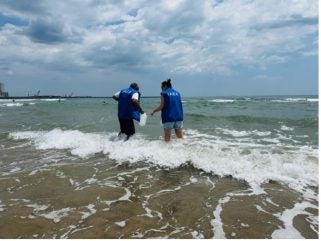
International Atomic Energy Agency (IAEA) experts confirmed that the tritium concentration in seawater samples taken from a popular beach destination in the city of Minamisoma in the Fukushima Prefecture is far below Japan’s operational limit.
Seawater from Kitaizumi Beach in Minamisoma was sampled by IAEA experts stationed at the Agency’s office at the site of the Fukushima Daiichi Nuclear Power Station, following consultation with the Government of Japan. The IAEA confirmed that the tritium concentration in the seawater from Kitaizumi Beach is far below the operational limit of 1500 becquerels per litre and is in line with international safety standards.
Minamisoma is about 30 kilometres north of the Fukushima NPP, where Tokyo Electric Power Company (Tepco) has been discharging diluted treated water since August 2023. Contaminated water, used to cool the melted reactor cores in the aftermath of the 2011 nuclear disaster at Fukushima, is stored in around 1,000 huge tanks at the plant containing more than 1.3m tonnes and total storage capacity has been reached. The contaminated cooling water and groundwater is treated by the Advanced Liquid Processing System (ALPS), which removes most of the radioactive contamination, with the exception of tritium.
TEPCO began discharging the seventh batch of ALPS-treated water, which is approximately 7800 cubic metres of water, on 28 June and plans to conduct a series of controlled discharges into the sea over a period of decades. The IAEA has earlier confirmed that the tritium concentrations in the seven batches of ALPS-treated water were far below operational limits.
In a comprehensive report issued in July 2023, the IAEA’s safety review found that Japan’s plan for handling the treated water was consistent with international safety standards and that the release as planned would have a negligible radiological impact to people and the environment.






